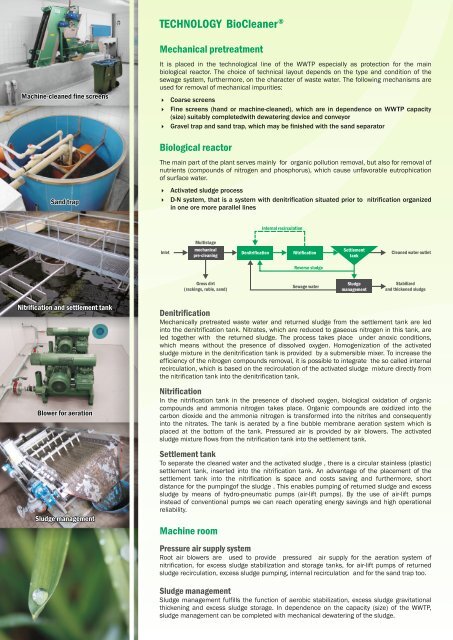Compact WWTP - ENVI-PUR
Compact WWTP - ENVI-PUR
Compact WWTP - ENVI-PUR
- TAGS
- compact
- wwtp
- envi-pur.cz
You also want an ePaper? Increase the reach of your titles
YUMPU automatically turns print PDFs into web optimized ePapers that Google loves.
Machine-cleaned fine screens<br />
Sand trap<br />
Nitrification and settlement tank<br />
Blower for aeration<br />
Sludge management<br />
®<br />
TECHNOLOGY BioCleaner<br />
Mechanical pretreatment<br />
It is placed in the technological line of the <strong>WWTP</strong> especially as protection for the main<br />
biological reactor. The choice of technical layout depends on the type and condition of the<br />
sewage system, furthermore, on the character of waste water. The following mechanisms are<br />
used for removal of mechanical impurities:<br />
4Coarse screens<br />
4Fine screens (hand or machine-cleaned), which are in dependence on <strong>WWTP</strong> capacity<br />
(size) suitably completedwith dewatering device and conveyor<br />
4Gravel trap and sand trap, which may be finished with the sand separator<br />
Biological reactor<br />
The main part of the plant serves mainly for organic pollution removal, but also for removal of<br />
nutrients (compounds of nitrogen and phosphorus), which cause unfavorable eutrophication<br />
of surface water.<br />
4Activated sludge process<br />
4D-N system, that is a system with denitrification situated prior to nitrification organized<br />
in one ore more parallel lines<br />
Inlet<br />
Denitrification<br />
Mechanically pretreated waste water and returned sludge from the settlement tank are led<br />
into the denitrification tank. Nitrates, which are reduced to gaseous nitrogen in this tank, are<br />
led together with the returned sludge. The process takes place under anoxic conditions,<br />
which means without the presence of dissolved oxygen. Homogenization of the activated<br />
sludge mixture in the denitrification tank is provided by a submersible mixer. To increase the<br />
efficiency of the nitrogen compounds removal, it is possible to integrate the so called internal<br />
recirculation, which is based on the recirculation of the activated sludge mixture directly from<br />
the nitrification tank into the denitrification tank.<br />
Nitrification<br />
Multistage<br />
mechanical<br />
pre-cleaning<br />
Gross dirt<br />
(rackings, ruble, sand)<br />
In the nitrification tank in the presence of disolved oxygen, biological oxidation of organic<br />
compounds and ammonia nitrogen takes place. Organic compounds are oxidized into the<br />
carbon dioxide and the ammonia nitrogen is transformed into the nitrites and consequently<br />
into the nitrates. The tank is aerated by a fine bubble membrane aeration system which is<br />
placed at the bottom of the tank. Pressured air is provided by air blowers. The activated<br />
sludge mixture flows from the nitrification tank into the settlement tank.<br />
Settlement tank<br />
To separate the cleaned water and the activated sludge , there is a circular stainless (plastic)<br />
settlement tank, inserted into the nitrification tank. An advantage of the placement of the<br />
settlement tank into the nitrification is space and costs saving and furthermore, short<br />
distance for the pumpingof the sludge . This enables pumping of returned sludge and excess<br />
sludge by means of hydro-pneumatic pumps (air-lift pumps). By the use of air-lift pumps<br />
instead of conventional pumps we can reach operating energy savings and high operational<br />
reliability.<br />
Machine room<br />
Pressure air supply system<br />
Root air blowers are used to provide pressured air supply for the aeration system of<br />
nitrification, for excess sludge stabilization and storage tanks, for air-lift pumps of returned<br />
sludge recirculation, excess sludge pumping, internal recirculation and for the sand trap too.<br />
Sludge management<br />
Denitrification<br />
Internal recirculation<br />
Nitrification<br />
Reverse sludge<br />
Sewage water<br />
Settlement<br />
tank<br />
Sludge<br />
management<br />
Cleaned water outlet<br />
Stabilized<br />
and thickened sludge<br />
Sludge management fulfills the function of aerobic stabilization, excess sludge gravitational<br />
thickening and excess sludge storage. In dependence on the capacity (size) of the <strong>WWTP</strong>,<br />
sludge management can be completed with mechanical dewatering of the sludge.




